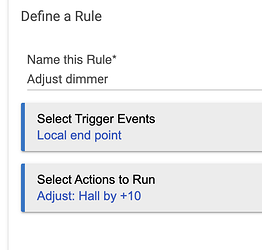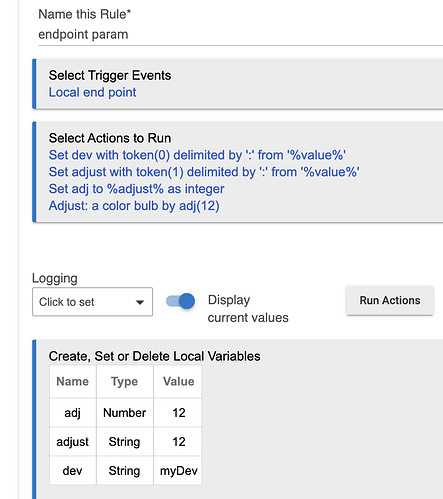Here is how this works:
First of all, we need to create an encoded string for the GET url parameter for the device and amount to adjust. This is an arbitrary encoding, and I just use "device:adjust", i.e, colon separation. The rule is going to get that string in %value% when the endpoint is hit, and it takes 3 steps: pull out 'device', pull out 'adjust', change adjust into an integer for a subsequent Adjust Dimmer action.
Here is what the GET against the endpoint looks like (this string can be found when the end point trigger is created, and then edited to add the parameter between the word trigger and ?):
http://192.168.0.45/apps/api/22259/trigger/myDev:12?access_token=8exxx..
So this string myDev:12 is the parameter that will be in %value%. myDev could just be the deviceId of the intended device, and 12 is the desired adjustment value.
Now, here's the base rule:
What would need to be done is to replace my single Adjust Dimmer action with a sequence of IF-THEN testing the value of the dev local variable, that holds the deviceId. Like this:
IF(dev = Dimmer1) THEN
Adjust Dimmer1 by %adj%
ELSE-IF(dev = Dimmer2) THEN
Adjust Dimmer2 by %adj%
...
END-IF
That's the basic scheme, and should work for your use case. Details left to you... Such as if using deviceId, then you'd need each IF or ELSE-IF to test for the correct deviceId of the corresponding dimmer to adjust.
Alternatively to the cascading IF-THEN-ELSE-IF approach, since there is only a single condition to test and a single action to run, you could use Simple Conditional Action instead, like this:
IF(dev = Dimmer1) Adjust Dimmer1 by %adj%
IF(dev = Dimmer2) Adjust Dimmer2 by %adj%
...
I tested this and it works as expected.
![]() For me, building the cache in the integration on start, then updating the local cache with the POST events works very, very well.
For me, building the cache in the integration on start, then updating the local cache with the POST events works very, very well.


